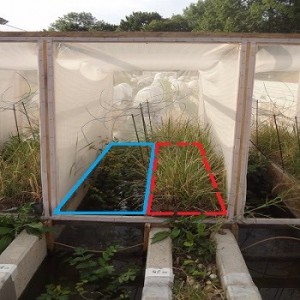In this post, Matthias Wieczorek informs about their recent paper on the use of an aquatic-terrestrial model ecosystem to study cross-ecosystem effects of contaminants.
The scientific background
Emerging aquatic insects provide an important food source for predatory species in riparian food webs. If these aquatic insects are exposed to contaminants during their aquatic life stage, they may transport contaminants to riparian ecosystems during their emergence. Therefore, riparian food webs may be at risk from either an aquatic-terrestrial transfer of contaminants or from contaminant-driven reductions of emerging aquatic biomass. The objective of the present study was to develop an aquatic-terrestrial model ecosystem enabling the possibility to investigate such cross-ecosystem effects on a mesocosm scale under controlled conditions.
The stream mesocosms
The study was conducted at the vegetated flow-through stream mesocosm facility at the University of Koblenz-Landau, Campus Landau (Figure 1). The stream mesocosm facility consists of 16 independent concrete channels which are equipped with sediment, aquatic macrophytes and different invertebrate species. These stream mesocosms allow to investigate ecotoxicological issues such as environmental fate of contaminants and potential effects on invertebrate populations or communities under replicated and controlled conditions.
The aquatic-terrestrial model ecosystem
To mimic a riparian ecosystem, aquatic-terrestrial model ecosystems with the riparian predator Tetragnatha extensa were integrated in the stream mesocosms using cages (Figure 2). Each of the cages contained a meadow section (red mark) and an equivalent water section (blue mark). In both sections, we assessed the emergence of insects and, thus, quantified potential food sources for the riparian model ecosystem.
As a representative species for riparian predators we inserted the widely distributed web-building spider T. extensa (Figure 3), which had the possibility to feed on both aquatic and terrestrial insects. Trophic aspects of the riparian food webs such as the composition of the spider diet were investigated by stable isotope analysis.
In ecotoxicological mesocosm testing, e.g. when applying a sorptive insecticide, this model ecosystem approach might enable insights in cross-ecosystem effects and pollutant transfer from aquatic streams to adjacent terrestrial systems. This testing approach thus includes inter alia potential bioaccumulation of pollutants and indirect effects.
The paper “Using stable isotope analysis in stream mesocosms to study potential effects of environmental chemicals on aquatic-terrestrial subsidies “ was authored by Matthias Wieczorek, Denise Kötter, René Gergs, and Ralf Schulz and was published in Environmental Science and Pollution Research.



